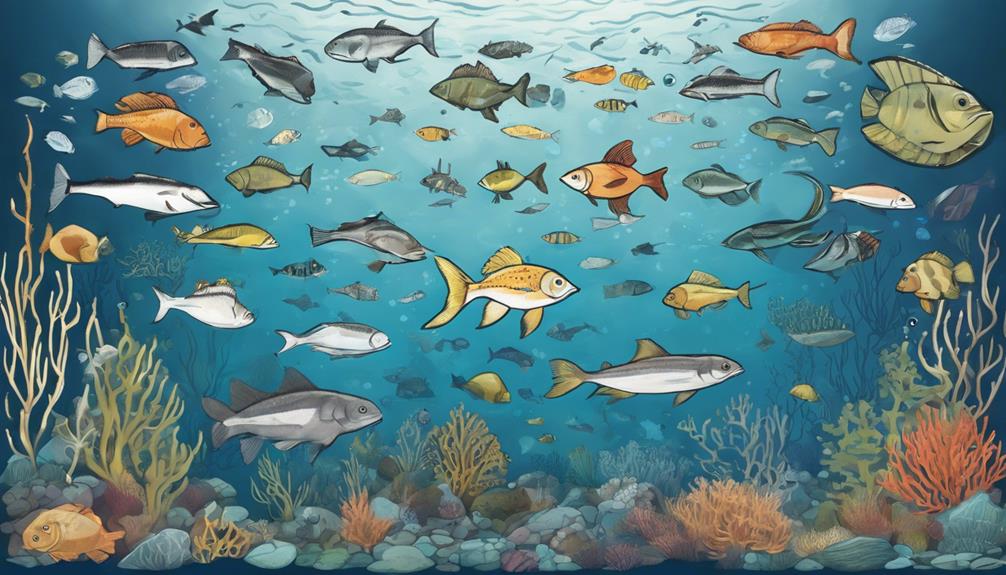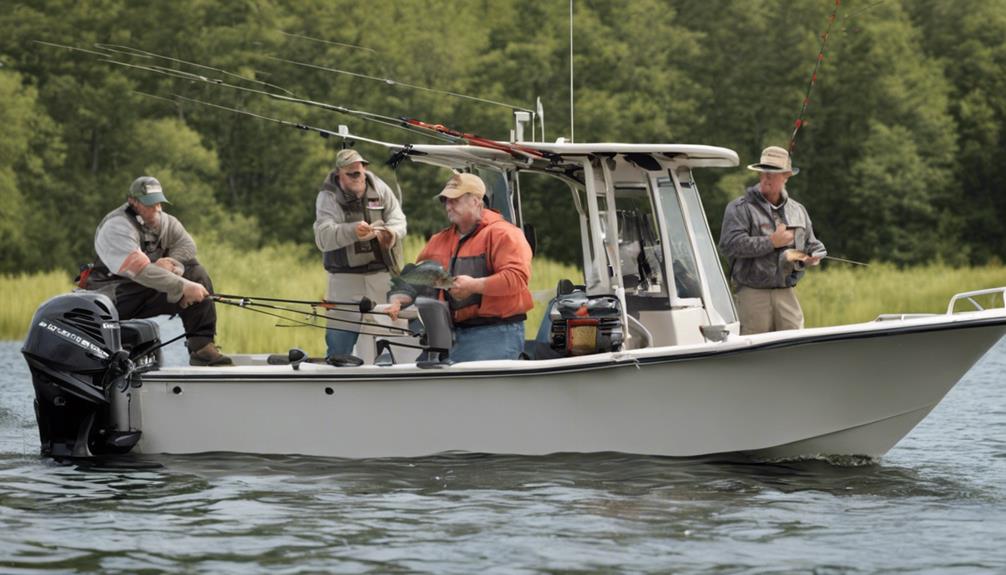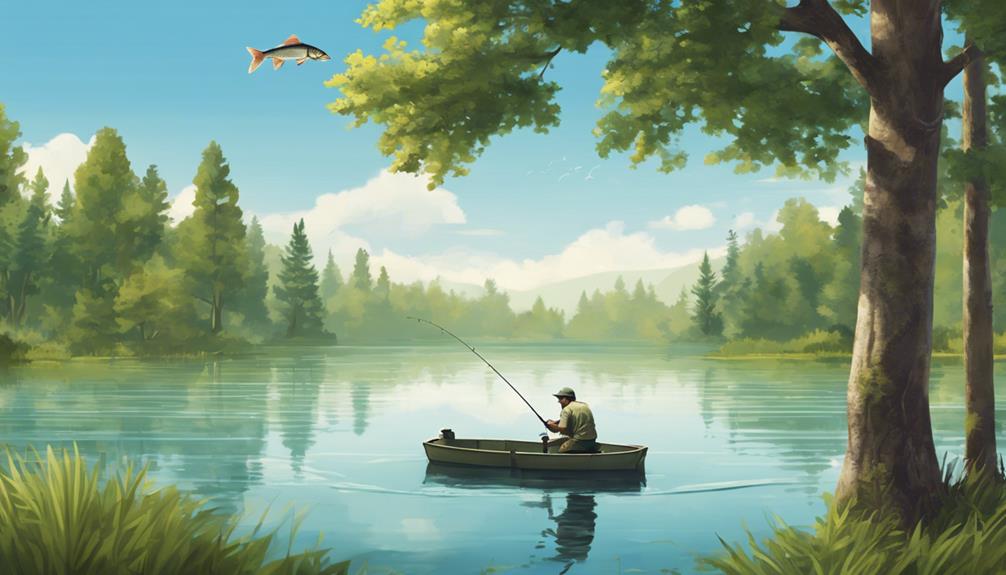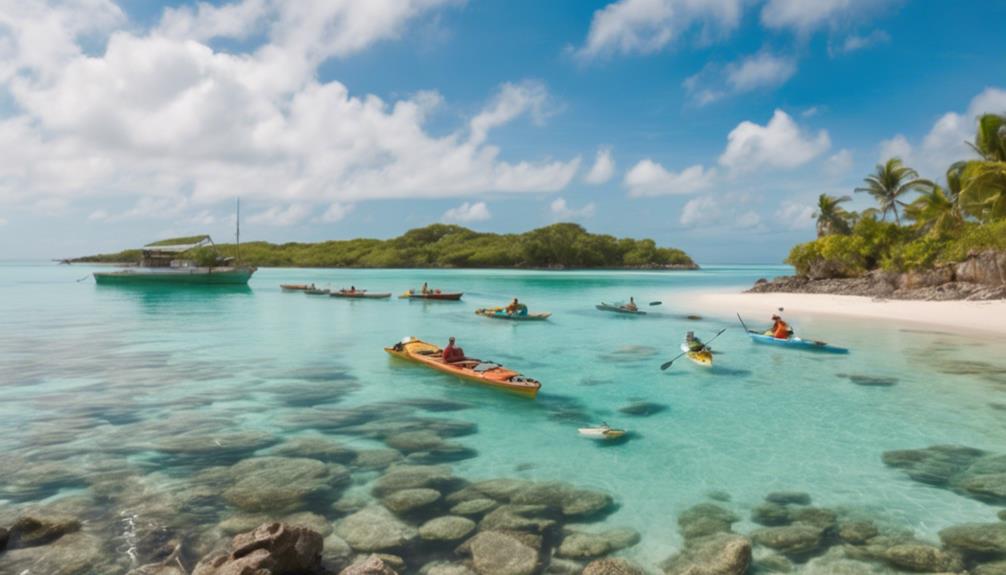Have you ever wondered how fishing regulations could truly impact the conservation of fish species? Understanding the intricate balance of marine ecosystems is crucial for effective management strategies.
By implementing a series of carefully crafted regulations, not only can fish populations be safeguarded, but entire ecosystems can thrive.
Let's explore fourteen essential tips that can help ensure the sustainability of our oceans and the preservation of marine biodiversity.
Importance of Fishing Regulations
Understanding the significance of fishing regulations is essential for the sustainable management of fish species. Promoting conservation through the implementation of fishing regulations is crucial in ensuring the long-term health of marine ecosystems. Sustainable fishing practices, which are enforced through these regulations, help prevent overfishing and depletion of fish populations.
By setting limits on the amount of fish that can be caught, fishing regulations aim to maintain healthy population levels of various fish species. These limits are designed to prevent the collapse of fish stocks and promote sustainable harvesting practices. Additionally, regulations often include guidelines on the size of fish that can be caught, allowing younger fish to mature and reproduce before being harvested.
Conservation efforts also extend to protecting habitats essential for fish spawning and growth. Fishing regulations may include restrictions on certain fishing methods or areas to minimize damage to critical habitats such as coral reefs, seagrass beds, and mangrove forests. By preserving these habitats, regulations help maintain the overall health and biodiversity of marine ecosystems.
Understanding Fish Population Dynamics
To grasp the dynamics of fish populations effectively, consider the interplay between fishing regulations and ecological factors influencing species abundance. Understanding fish population dynamics is crucial for sustainable management and conservation efforts. Fish population growth is influenced by various factors such as reproduction rates, predation, habitat quality, and fishing pressure.
Effective fishing regulations play a vital role in maintaining healthy fish populations. By imposing catch limits, regulating fishing gear, and establishing no-take zones, authorities can help prevent overfishing and promote sustainable management practices. These regulations aim to strike a balance between human consumption needs and the preservation of fish species for future generations.
Monitoring fish populations through scientific surveys and data analysis is essential for making informed decisions regarding fishing regulations. By tracking population trends, scientists and policymakers can adjust management strategies to ensure the long-term health and sustainability of fish stocks.
Implementing Size Limits
Implementing size limits is a crucial strategy in regulating fishing practices to ensure the sustainability of fish populations. Size restrictions help in protecting fish during their reproductive years, allowing them to spawn and contribute to the replenishment of their populations.
Here are some key points to understand the importance of size limits:
- Protecting Reproductive Potential: Enforcing size restrictions ensures that fish have the opportunity to reach maturity before being harvested, safeguarding their ability to reproduce.
- Maintaining Population Balance: By allowing fish to grow to a certain size before being caught, size limits help maintain a healthy balance within fish populations.
- Preventing Overfishing: Size limits prevent the excessive removal of juvenile fish, which is essential for sustainable harvesting and preventing the collapse of fish stocks.
- Enhancing Ecosystem Resilience: Sustainable harvesting through size restrictions contributes to the overall health of marine ecosystems by preserving the natural dynamics of predator-prey relationships and biodiversity.
Enforcing Catch Limits
Enforcing catch limits is essential for maintaining the sustainability of fish populations and preventing overexploitation. Without proper enforcement, regulations on catch limits become ineffective. To ensure that fish stocks aren't depleted beyond sustainable levels, enforcement strategies must be robust and backed by thorough compliance monitoring.
Effective enforcement strategies involve a combination of methods. Regular patrols by fisheries officers help deter illegal fishing practices and ensure that catch limits are being adhered to. Surveillance technologies, such as drones and GPS tracking systems, can also be utilized to monitor fishing activities in real-time and detect any violations promptly.
Compliance monitoring plays a crucial role in enforcing catch limits. By closely monitoring catch data and comparing it against established limits, authorities can identify discrepancies and take necessary enforcement actions. Random inspections of fishing vessels and landing sites can further deter violations and promote compliance with catch limits.
In addition to traditional enforcement methods, community involvement and education are vital for ensuring widespread compliance. By raising awareness about the importance of catch limits and the consequences of overfishing, stakeholders can become active participants in conservation efforts.
Designating Marine Protected Areas
Ensuring the long-term protection of fish species and their habitats involves the strategic designation of Marine Protected Areas. By designating these areas, you can actively contribute to ecosystem protection and biodiversity conservation.
Here are four key reasons why Marine Protected Areas are crucial for conserving fish species:
- Preservation of Habitats: Marine Protected Areas safeguard crucial habitats such as coral reefs, seagrass beds, and mangroves, providing essential breeding grounds and shelter for various fish species.
- Population Recovery: By limiting human activities like fishing and coastal development, Marine Protected Areas allow fish populations to recover, ensuring sustainable fish stocks for the future.
- Enhanced Biodiversity: These protected zones promote species diversity by offering a safe haven for a wide range of marine organisms, contributing to the overall health of the ecosystem.
- Research and Monitoring: Marine Protected Areas serve as living laboratories for scientists to study marine life, monitor ecosystems, and develop strategies for better conservation efforts.
Prohibiting Harmful Fishing Practices
To safeguard fish populations and marine ecosystems, addressing harmful fishing practices is imperative. Reducing bycatch and promoting sustainable methods are crucial steps in conserving fish species. Bycatch, which includes unintended species caught during fishing operations, can have devastating effects on marine biodiversity. Implementing regulations that require the use of selective gear and techniques can significantly reduce bycatch. For example, using circle hooks instead of J-hooks when fishing for certain species can help prevent the accidental capture of non-targeted marine life.
Additionally, promoting sustainable fishing methods such as hook-and-line fishing or using traps instead of more destructive methods like bottom trawling can help preserve fish populations and their habitats. Sustainable practices not only benefit fish populations but also support the long-term viability of fishing communities. By avoiding harmful practices that deplete fish stocks or damage marine ecosystems, fishermen can ensure a stable livelihood for future generations.
Educating fishermen about the importance of reducing bycatch and adopting sustainable fishing methods is key to successfully conserving fish species. Collaborating with local communities, fisheries management organizations, and researchers can help implement effective regulations and initiatives to protect marine life. Prohibiting harmful fishing practices is a critical step towards ensuring the health and sustainability of our oceans and the fish species that depend on them.
Monitoring and Research Initiatives

Now, shifting focus to monitoring and research initiatives can provide valuable insights into the effectiveness of current conservation efforts and guide future strategies for protecting fish species and marine ecosystems. Conducting thorough research and monitoring programs is crucial in understanding the impact of regulations and ensuring the sustainability of fish populations. Here are four key points to consider:
- Research Findings: Regularly analyzing research findings allows policymakers to make informed decisions based on scientific evidence. By studying fish populations, habitats, and ecosystem dynamics, conservation efforts can be tailored to address specific needs and challenges.
- Conservation Efforts Evaluation: Monitoring the outcomes of conservation efforts is essential to determine their success and identify areas for improvement. By tracking changes in fish populations and habitats over time, researchers can assess the effectiveness of regulations and adjust strategies accordingly.
- Adapting Strategies: Research initiatives help in adapting conservation strategies to evolving environmental conditions and emerging threats. By staying up-to-date with the latest findings, policymakers can implement proactive measures to safeguard fish species and their habitats.
- Long-Term Sustainability: Monitoring programs contribute to the long-term sustainability of fish populations and marine ecosystems. By gathering data consistently, researchers can detect trends, predict future scenarios, and implement measures to ensure the well-being of aquatic life.
Through continuous monitoring and research, conservation efforts can be optimized to protect fish species and preserve the delicate balance of marine ecosystems.
Collaborating With Stakeholders
Collaborating with stakeholders is key to fostering effective communication and cooperation in conservation efforts for fish species and marine ecosystems. Stakeholder engagement plays a crucial role in ensuring that all relevant parties are involved in decision-making processes and are committed to the long-term sustainability of fish populations. By actively involving stakeholders such as fishing communities, environmental organizations, government agencies, and scientific researchers, a more holistic and inclusive approach to conservation can be achieved.
Community partnerships are vital in creating shared goals and promoting collective action towards protecting fish species. By working together with local communities that rely on fishing for their livelihoods, conservation initiatives can be designed to balance environmental needs with socio-economic considerations. These partnerships can also help in raising awareness about the importance of sustainable fishing practices and the preservation of marine ecosystems.
Effective collaboration with stakeholders can lead to the development of well-informed policies and regulations that are supported by those directly impacted by them. By incorporating diverse perspectives and expertise, conservation efforts can be more adaptive and responsive to changing environmental conditions. Ultimately, by building strong relationships with stakeholders and fostering a sense of shared responsibility, the conservation of fish species can be better ensured for future generations.
Frequently Asked Questions
How Do Fishing Regulations Vary Between Different Countries and Regions?
Fishing regulations vary widely between countries and regions. Global comparison reveals diverse enforcement strategies to protect fish species.
Different economies experience varied impacts due to these regulations, affecting local fishing industries. Sustainability efforts differ, with some areas focusing more on conservation while others prioritize economic gains.
Understanding these differences is crucial for effective fisheries management and ensuring the long-term health of marine ecosystems.
Are There Any Exceptions or Loopholes in Fishing Regulations That Could Potentially Harm Fish Populations?
When it comes to fishing regulations, loopholes exist that can harm fish populations. Inadequate enforcement of rules can lead to overfishing and threaten the sustainability of marine life.
It's crucial to address these loopholes to ensure effective conservation efforts. By closing these gaps and strengthening enforcement measures, we can better protect fish species and promote their long-term sustainability.
How Do Fishing Regulations Impact Indigenous Communities That Rely on Fishing for Their Livelihood?
Fishing regulations have a significant economic impact on indigenous communities that depend on fishing for their livelihood. These rules can affect income sources and traditional practices, impacting cultural preservation.
It's crucial to find a balance that protects fish species while also considering the needs of these communities. By understanding the unique challenges faced by indigenous groups, regulations can be tailored to support both conservation efforts and the cultural heritage of these communities.
What Role Do Consumer Awareness and Demand Play in the Enforcement of Fishing Regulations?
Consumer education plays a crucial role in enforcing fishing regulations. When consumers are aware of sustainable practices, they can make informed choices that support the conservation of fish species.
How Can Technology and Innovation Be Utilized to Improve the Effectiveness of Fishing Regulations in Conserving Fish Species?
To enhance fishing regulations, you can leverage technological solutions like satellite tracking for monitoring vessels and drones for surveillance.
Innovative approaches such as implementing real-time data analysis can improve enforcement efficiency.
By embracing these tools, you'll boost the effectiveness of conservation efforts and ensure sustainable fish populations.
Stay ahead of the game with cutting-edge methods that help safeguard marine ecosystems for future generations.
Conclusion
By following these tips for conserving fish species through regulations, you can play a vital role in protecting our marine ecosystems. Remember to abide by size and catch limits, support marine protected areas, and advocate for sustainable fishing practices.
Stay informed, engage with stakeholders, and continue to monitor and research fish populations.
Together, we can ensure the health and abundance of our oceans for future generations to enjoy.



